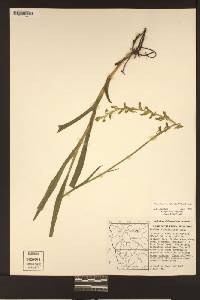Platanthera sparsiflora
|
|
|
|
Family: Orchidaceae
Canyon Bog Orchid, more...sparse-flowered bog orchid
[Habenaria aggregata, moreHabenaria sparsiflora S. Watson, Limnorchis laxiflora , Platanthera sparsiflora var. ensiflora (Rydb.) Luer] |
Plants 20-125 cm or more. Leaves few-several, ascending to recurved-spreading, scattered along stem or sometimes clustered near base, gradually to abruptly reduced to bracts distally; blade ovate-, oblong-, or oblanceolate-elliptic to linear, 6.5-30 × 0.8-5 cm. Spikes very lax to dense. Flowers resupinate, not showy, green to yellowish green; lateral sepals reflexed or sometimes spreading; petals ovate- to lance-falcate, margins entire; lip descending or reflexed, oblong or linear to linear-oblong or linear-lanceolate, a thickened median basal ridge present or absent, 4.5-11 × 0.6-3 mm, margins entire; spur slightly clavate, cylindric, or tapering toward usually rather acute apex; rostellum lobes somewhat divergent, directed forward, rounded-subangular, rather prominent, to strongly divergent, very small, rounded, obscure; pollinaria straight; pollinia remaining enclosed in anther sacs; viscidia orbiculate to oblong; ovary rather slender to stout, mostly 5-14 mm. 2n = 42. Flowering Apr--Sep. Wet meadows, marshes, fens, stream banks, shores, seeping slopes; 0--3500 m; Ariz., Calif., Colo., Nev., N.Mex., Oreg., Utah; Mexico (Baja California). The columns of Platanthera sparsiflora, P. brevifolia, and P. zothecina differ from those of superficially similar species in their comparatively large, diverging, and forward-directed rostellum lobes; they are typical of columns of Platanthera species that deposit pollinaria on insects´ compound eyes. The resulting broad column fills a large portion (generally about 2/3) of the width of the hood formed by the dorsal sepal and petals, and in live and well-prepared herbarium specimens this feature separates these species from their relatives with proportionately smaller, narrower columns. Selection for more generalized pollination mechanisms, as is known elsewhere in the genus, however, has apparently produced derivatives of P. sparsiflora with reduced columns that simulate members of the P. hyperborea complex. The use of column structure, as has been traditionally employed to delimit P. sparsiflora, therefore actually recognizes a pollination syndrome and may not be adequate to represent the evolutionary and systematic status of this group. Platanthera sparsiflora is highly variable in both vegetative habit and flower structure. Plants may be rather short, stout, with numerous broad leaves scattered along the stem and a rather dense inflorescence of comparatively large flowers. Others are tall and very slender, with few small, ascending leaves widely spaced on the proximal portions of the stem and very lax inflorescences of small flowers (Limnorchis laxiflora Rydberg). Others, with long, usually dense inflorescences of small flowers distal to basal clusters of leaves, have recently been treated as Limnorchis ensifolia by W. A. Weber (1990). These last, also discussed at length by D. S. Correll (1950) under Habenaria sparsiflora var. laxiflora, are characterized by smaller columns in which the reduced rostellum lobes appear to be folded forward, replacing the typical hemispheric chamber with a narrower fissure. Flower size in some plants furthermore may vary greatly in different years. Spurs vary from uniformly tapering to clavate, extending stiffly along the ovary to curving forward, and in length range from slightly shorter than the lip to about 1.6 times its length. In both vegetative and floral characters various degrees of intermediacy and combinations of character extremes occur. The complex including the three species recognized here is currently under critical study.
FNA 2002, Cronquist et al. 1977, Welsh et al. 1993, Kearney and Peebles 1964 Duration: Perennial Nativity: Native Lifeform: Forb/Herb General: Erect glabrous perennial 20-125 cm, light green with generally leafy stems. Leaves: Variable and scattered but all sheathing on lower half of stem, ascending to recurved, oblong-elliptic to linear-lanceolate, 6.5-30 cm long by 1-5 cm wide. Flowers: Lax, few to many flowered spike 10-45 cm long and 1-3 cm wide, resupinate flowers, not showy, green to yellowish green, lateral sepals reflexed to spreading, petals fleshy, ovate to lance falcate, margins entire, lip descending or reflexed, oblong to linear, with thickened median basal ridge 4,5-11 mm long by 0.5-3 mm wide, margins entire; slightly clavate spur, cylindric to tapering toward acute apex, small; column prominent, more than half as long as upper sepal, pollen sacs about 2 mm long. Fruits: Ellipsoid capsule to 1.5 cm long. Ecology: Found in wet meadows, marshes, streambanks, at seeps and springs from 5,000-9,000 ft ( 1524-2743 m); flowers June-October. Notes: Highly variable in vegetative habit and flower structure. Ethnobotany: Used as a famine food. Etymology: Platanthera is from Greek for flat and flower, for the wide flat anther, while sparsiflora means few flowered. Synonyms: None Editor: SBuckley, 2010 |



















































































